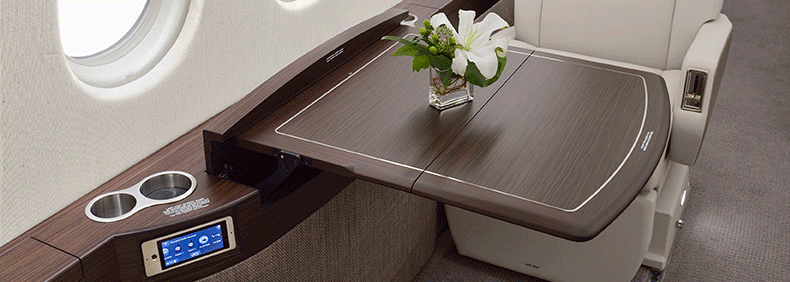
In part 2 of this 3-part series about CMS equipment, you’ll learn about available CMS audio options and their benefits.
Series Schedule
Part 1: Cabin Displays
Part 2: Audio Options
Part 3: Cabin Source Equipment (May Duncan Intelligence)
For more information and greater detail, you can download the Duncan Aviation Straight Talk About CMS, here: www.DuncanAviation.aero/resources/straight-talk/cabin-management-systems
AUDIO OPTIONS
Aircraft audio refers to personal use audio via headsets and speaker options for the entire cabin. Operators will likely want a combination of the two to create cabin space that satisfies all audio needs.
All options we mention here include a PA (Passenger Address) system that allows the cockpit to override the cabin audio with safety announcements.
Headphone
Most business aircraft now accommodate wired headphones in the cabin. Wired headsets plug into an audio jack, typically part of the PCU (Passenger Control Unit). The source options and volume controls are also integrated into the PCU and are conveniently mounted for individual use at most seating positions in the cabin.
Soon, you may start seeing cabins with no audio jacks. Popular personal Bluetooth headsets now interface with smartphones and other personal electronic devices. They are small, have a long battery life, and are not susceptible to interference. Bluetooth wireless receivers and transmitters are also available for connecting to aircraft CMSes.
Cabin Speakers
We’ve found that aircraft come equipped with various types of cabin speakers, from consumer-grade speakers designed for the automotive market to high-end systems that are designed and certified for use in aircraft. Regardless of the speaker type, they deteriorate over time, and it’s a good idea to replace them during an interior refurbishment or CMS upgrade.
We recommend high-quality speakers that are designed and certified for aircraft use. They typically come with an audio amplifier (or two) and digital interfaces to the CMS. Mid-bass/tweet speakers are typically mounted in the PSU, while the subwoofer speakers are mounted under the chairs or sidewalls/bulkhead cabinets.
Today’s speaker systems are designed for and specifically tuned to the aircraft environment. Acoustic engineers determine the locations based on the specific cabin sizes and layouts, and then they set up specialized equipment in the cabin to tune the system for the best possible audio quality.
Additional speakers designed for surround sound are installed in the cabin and specifically tuned by the acoustic engineer.
Speakerless System
Another option to consider is a new speakerless system. Yes, that’s right: speakerless.
Speakerless cabins are possible through signal processing and small audio transducers installed on the backsides of the existing cabin ceiling and sidewall panels. The interior panels become the speakers with these transducers affixed to them throughout the cabin. The result is an immersive audio experience without the need for speaker grills.
As with any cabin upgrade, weighing all of your options is important. Base your decisions on the aircraft’s mission, as well as the operator’s individual preferences and budget.
For more information and greater detail, you can download the Duncan Aviation Straight Talk About CMS, here: www.DuncanAviation.aero/resources/straight-talk/cabin-management-systems
December 2025
December 2025
November 2025
October 2025
October 2025